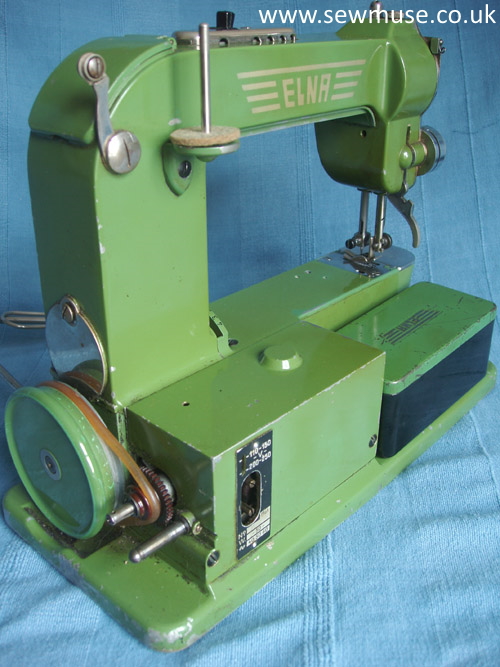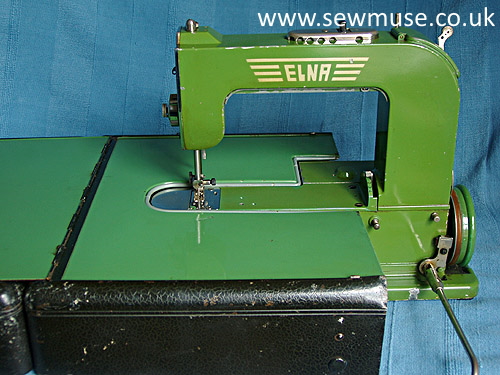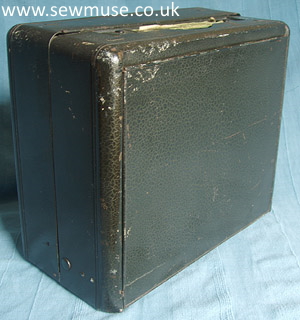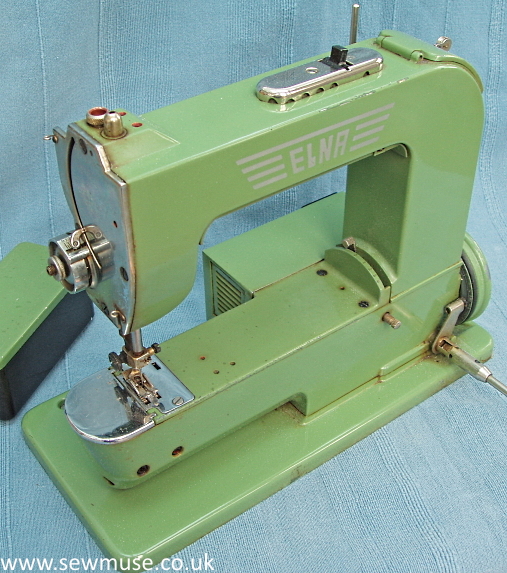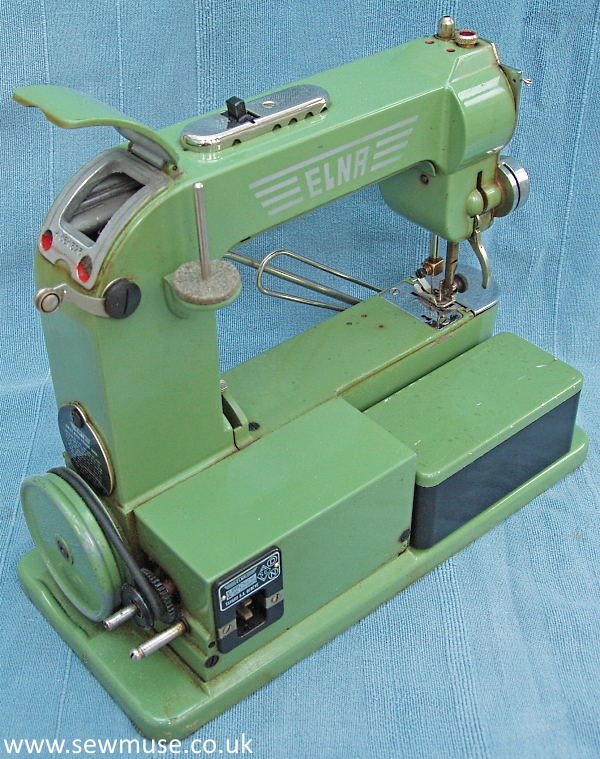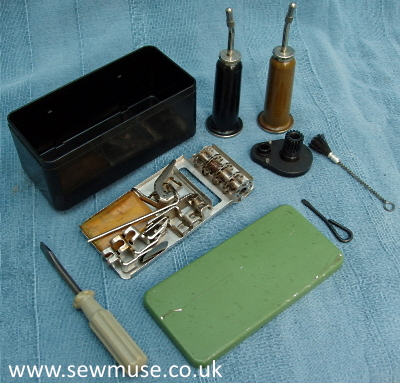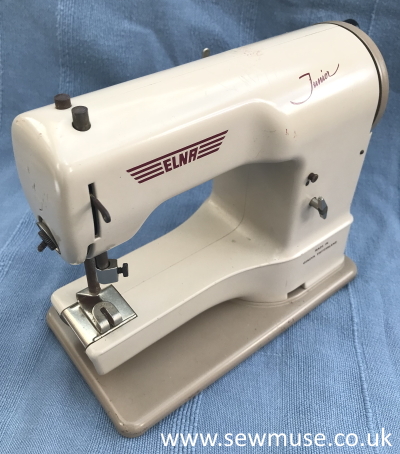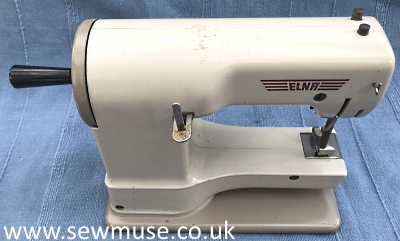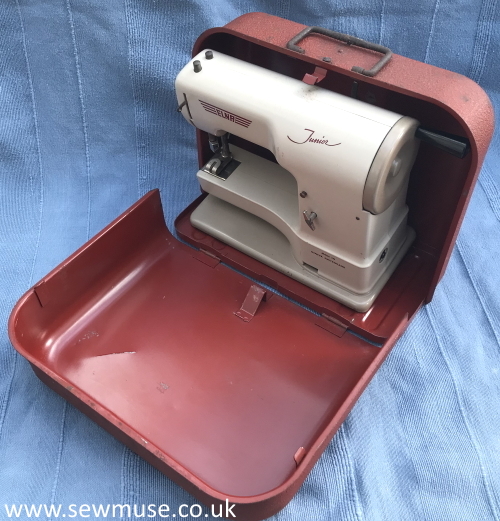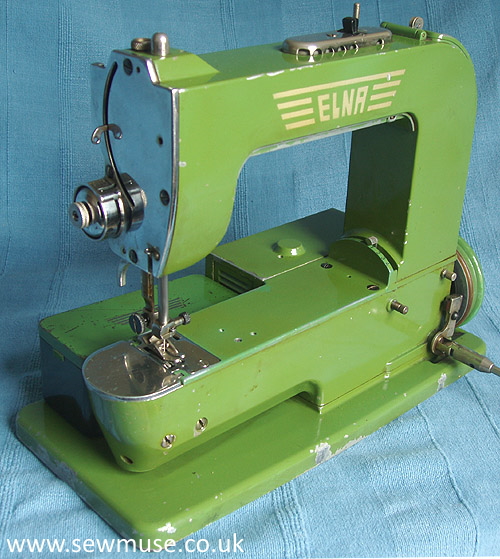
Elna: Serial No. 011217.
This machine was made by the Swiss firm Tavaro S. A., Geneva, Switzerland. The Company started manufacturing sewing machines in 1934 and the Elna was introduced in 1940. Designed by Ramon Casas it was the first modern free arm portable machine weighing 14.5 lbs. It proved to be extremely popular and by 1949 was being sold in 25 countries.
Manufactured until 1952 the Elna under went very minor modifications during its production most notably to the motor and its housing.
Initially the Elna did not carry a model number but has since become known as the Elna No.1, it also has the affectionate nick-name of "Grasshopper".
Dating Elna Sewing Machines
For all Elna sewing machines manufactured up to and including 1962 the first digit of the machines serial number represents the year of manufacture. For example 0 could represent 1940, 1950, or 1960, so this needs to be combined with a general awareness of when a particular model was introduced and any design changes made during production.
From 1963 to 1981 the year of manufacture is indicated by the following letters:
A=1963, B=1964, C=1965, D=1966, E=1967, F=1968, G/H=1969, K=1970, L=1971, M=1972, N= 1973, P=1974, R=1975, S=1976, T=1977, U=1978, V=1979, X=1980, Y=1981.
Produced in 1940 this machine shows signs of wear, sadly the internal electrics have been condemned, making this purely a display model. The main castings were produced in Aluminium, the case, which converts to a work platform, is made of sheet steel. It came complete with manual and an accessory tin containing an ingenious speed reducer which when attached to the motor axle uses gears to slow the machine considerably, and is designed to be used when embroidery work is being carried out.
Not only was the design of the Elna innovative, but the green finish was highly unusual at a time when most machines were being finished in black and gold. Note the light is built into the arm and how the accessory box fits snugly against the machine when not in use.
The bulge in the top of the motor cover can clearly be seen in the photograph above, on later versions the motor was changed so the motor cover was flat - see machine below.
The case shown in the photo left has a crinkle black finish and is sometimes described as looking like an ammunition box! However once the machine has been removed it folds out to form a spacious work platform. Later versions have a green case with plastic handle.
This machine was kindly donated to our collection by Sandra Eyston
Elna: Serial No. 1361523.
A later Elna machine made in 1951 and identifiable by it's flat motor housing and improved brake.
The serial number on these models is underneath the cover which is shown open on the picture below. The black circular inspection cover lower down has details of various patents from 1937 to 1940.
I bought this machine many years ago sight unseen and it immediately went into storage without me even opening the case so imagine my delight on finally opening the accessory box to find not just feet, bobbins and needles but also the two original oil cans!
The green can is stamped Huile Oil on the nickel plated top and the black one has Petrole Kerosene, they are beautifully designed and each comes with a screw cap.
Both are marked Elna on the base rim
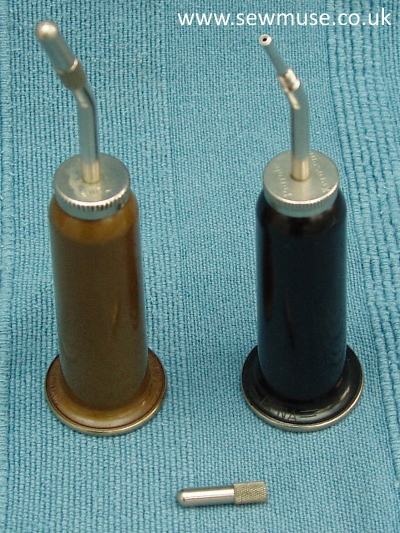
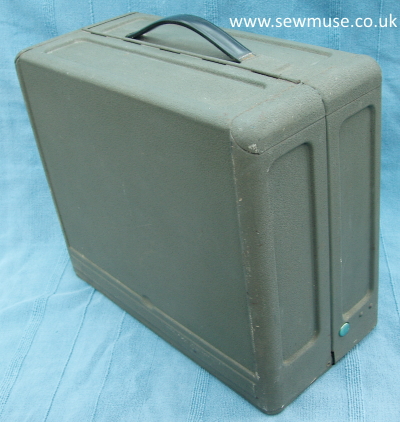
The green case folds out in a similar manner to the earlier machine above.
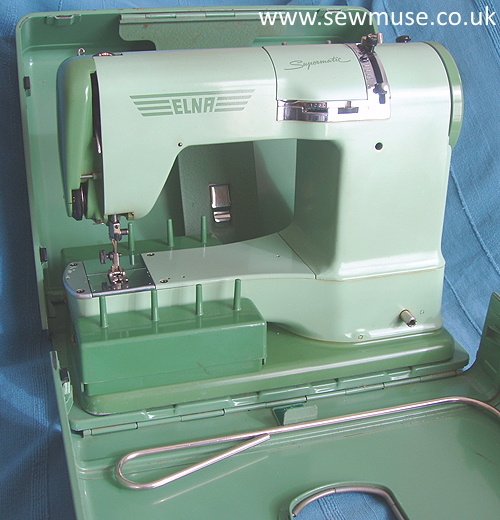
Elna Supermatic: Serial No. 7889055.
The Elna Supermatic was the world's first fully automatic household sewing machine. It was revolutionary as it allowed many different forms of decorative stitch with a hand made look, the machine gently moving the fabric back and forth while the needle swung from side to side. It could sew with twin needles.
To produce different stitches the machine used interchangeable discs which fitted into what the sales literature refered to as the "Miracle Brain" more formally known as the Elnagraph Regulating Device. This was fitted to the Elna Supermatic as standard and could be retrofitted to the Elna Zig Zag and Elna Transforma machines.
The Elna Supermatic series was introduced in August 1952, early versions were dark green and the removal of the discs was done using a bakelite nut and fork. This was changed to a push button release in 1956 with the machines being produced in two tone green. Machines made from 1958 were beige/brown in colour and the final version produced in 1963 and 1964 was two tone grey. The Elna Supermatic was replaced in 1964 by the Star series.
Produced in 1957 this machine shows some evidence of wear but what makes it particularly special is the quantity of original documentation that came with it. It has original sales leaflets, accessory price lists, leaflet of Elna discs, Elna ideas book, instruction manual, factory test stitch sample even the original voltage label! The sales reciept shows the machine was purchased from Joyce Webb Ltd, Catherine Street, St. Albans, Herts on 27th January 1958 for £98 15s.
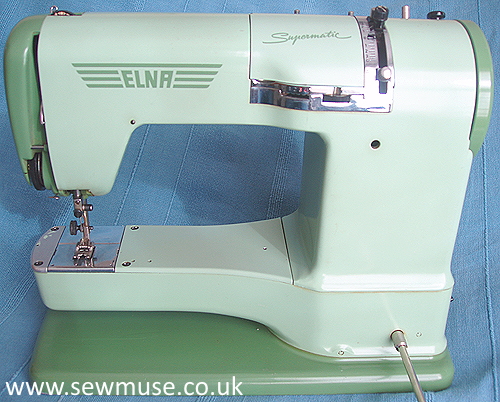
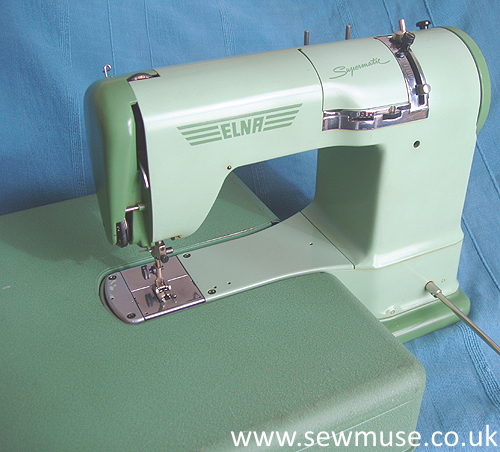
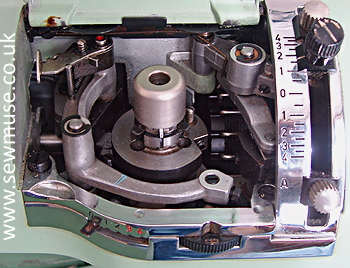
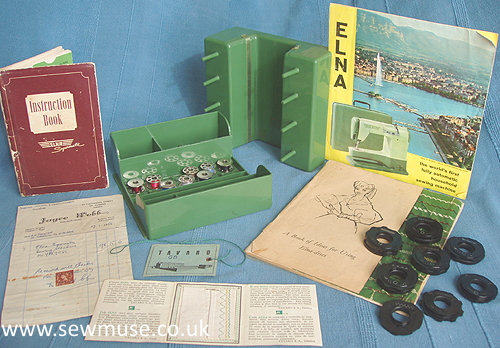
Shown left - some of the accessories and documentation which came with the machine. At the front is the original factory test stitch sample and above the voltage label which shows an illustration of the Tavaro factory.
Also shown are some of the Elna discs which when inserted into the "miracle brain" (shown above) allowed decorative stitching. Six single and four double discs were supplied with the machine and additional discs could be purchased.
The case has a crinkle green finish and once the machine has been removed it folds out to form a spacious work platform.
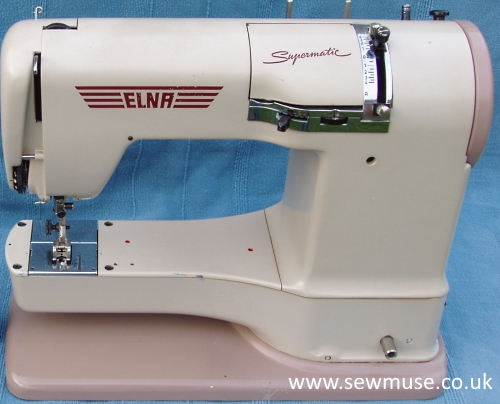
Elna Supermatic: Serial No.1186834.
Produced in 1961 this Elan Supermatic sports the two tone beige/brown livery. It has all the features of the earlier machine but the case has been redesigned. The front now lifts off and forms a separate work platform which is smaller than the previous model.
This machine came with a range of Elna booklets and other Elna publications including two manuals one "We demonstrate the Elna Supermatic" and the other the "General Mechanical Training Manual Elna". These manuals would originally have been provided to official Elna Sales Representatives and Service Engineers but were obtained by the original owner of the machine from Leighton Baldwin (Sales) Ltd which was the main wholesaler of Elna Machines in Great Britain.
In the back of one of the other booklets there is a letter from Leighton Baldwin dated August 1958 outlining the benefits of the Elna Supermatic and offering a demonstration of the machine at Kendal Milne, Deansgate, Manchester.
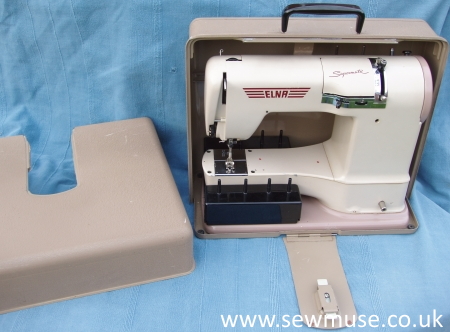
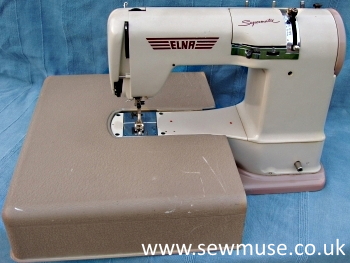
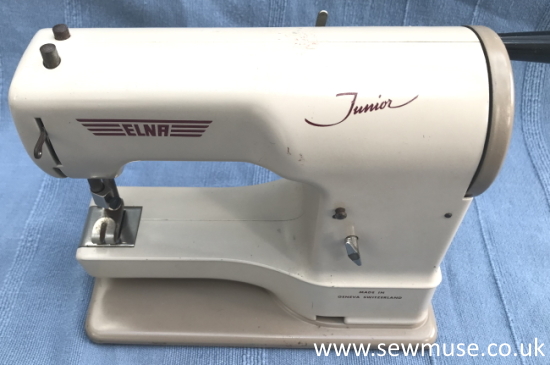
Elna Junior: Serial No. - .
The Elna Junior was a toy machine which took it's overall shape from the Supermatic. Two versions existed one with a music box the other without and it was available in two tone green and two tone beige/brown
This version has the music box which plays the Blue Danube waltz. The mechanism was frozen when I bought it but WD40 worked a treat! It has a red metal carry case.
This machine does not have a serial number but other versions have a number stamped on the underside of the machine. The Elna Junior was produced from around 1956 to the early 1960's

